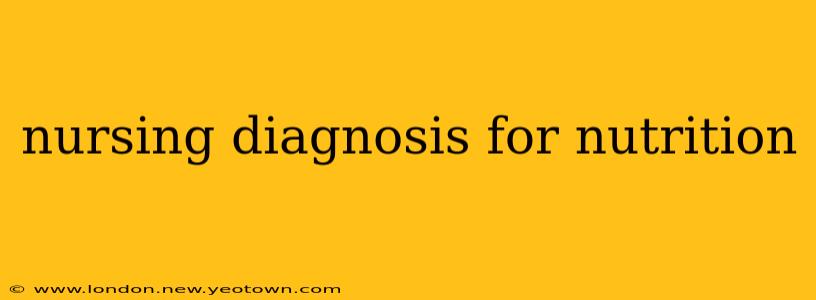Unraveling the Mysteries of Nutritional Nursing Diagnoses: A Story of Nourishment and Care
The world of nursing is a tapestry woven with threads of compassion, knowledge, and unwavering dedication. One crucial strand in this intricate design is the assessment and management of a patient's nutritional status. A cornerstone of this process is the accurate formulation of a nursing diagnosis related to nutrition. This isn't just about ticking boxes; it's about understanding the individual's story and crafting a plan to help them thrive.
Imagine Sarah, a 72-year-old woman recovering from a stroke. She's struggling to swallow, her appetite is diminished, and she's lost considerable weight. This isn't just a number on a scale; it's a sign that her body isn't receiving the nourishment it needs to heal and regain its strength. This is where the power of a nursing diagnosis comes into play.
What are the Common Nutritional Nursing Diagnoses?
Several potential nursing diagnoses could apply to Sarah, and understanding these is key to providing effective care. Let's explore some of the most common:
1. Imbalanced Nutrition: Less Than Body Requirements: This is a frequently used diagnosis when a patient's nutritional intake is insufficient to meet their metabolic needs. Sarah's reduced appetite and swallowing difficulties clearly fit this diagnosis. We need to understand why she's not eating enough: Is it the stroke's impact on swallowing, depression, or something else? The more we understand the root cause, the more effective our interventions can be.
2. Imbalanced Nutrition: More Than Body Requirements: This diagnosis is the opposite – it indicates excessive nutritional intake leading to obesity or other weight-related problems. While not applicable to Sarah, it's crucial to remember that nutritional imbalances can manifest in many ways.
3. Risk for Imbalanced Nutrition: Less Than Body Requirements: This diagnosis is used when a patient is at risk of developing insufficient nutritional intake. Perhaps a patient is recovering from surgery and anticipates difficulty eating, or they're undergoing chemotherapy, which often affects appetite. Proactive measures are crucial here to prevent nutritional deficiencies.
4. Impaired Swallowing (Dysphagia): This diagnosis directly addresses Sarah's difficulty swallowing. This isn't just about the lack of nutrition; it's about the safety of eating. We need to assess the risk of aspiration (food entering the lungs) and implement strategies to ensure safe and effective swallowing.
5. Readiness for Enhanced Nutrition: Even if a patient has existing nutritional challenges, they may demonstrate a desire for improvement. This diagnosis acknowledges the patient's motivation and provides a positive starting point for collaborative goal setting. This could be the case later in Sarah's recovery as she gains strength and confidence.
How Do I Choose the Right Nursing Diagnosis?
Selecting the correct nursing diagnosis is a crucial step. It requires a thorough assessment, considering:
- Physical Assessment: Weight, height, body mass index (BMI), muscle mass, skin turgor, and any signs of malnutrition.
- Dietary Intake: A review of food intake patterns, including meal frequency, portion sizes, and types of food consumed.
- Laboratory Data: Blood tests can reveal deficiencies in vitamins, minerals, or proteins.
- Patient History: Medical conditions, medications, cultural preferences, and lifestyle factors can all influence nutritional status.
- Patient's Subjective Reports: The patient's own feelings about food, appetite, and any related challenges are vital.
What are the Potential Interventions for Nutritional Deficiencies?
Once the diagnosis is made, the next step is to create a plan of care. Interventions for nutritional deficiencies might include:
- Dietary Modifications: Adjusting the texture, consistency, and type of food to meet the patient's needs. For Sarah, this might involve pureed foods or thickened liquids.
- Nutritional Supplements: Adding vitamins, minerals, or protein supplements to ensure adequate intake.
- Enteral Nutrition: Providing nutrition directly into the stomach or small intestine through a tube if oral intake is insufficient.
- Parenteral Nutrition: Providing nutrition intravenously if the gastrointestinal tract is unable to function.
- Education and Counseling: Educating the patient and family about healthy eating habits and strategies to improve nutritional intake.
By accurately diagnosing Sarah's nutritional needs and implementing appropriate interventions, we can support her recovery, enhance her quality of life, and help her reach her full potential. This holistic approach to nutritional care, grounded in accurate nursing diagnoses, is the heart of compassionate and effective patient care. It’s not just about numbers; it’s about nurturing individuals back to health and well-being.

